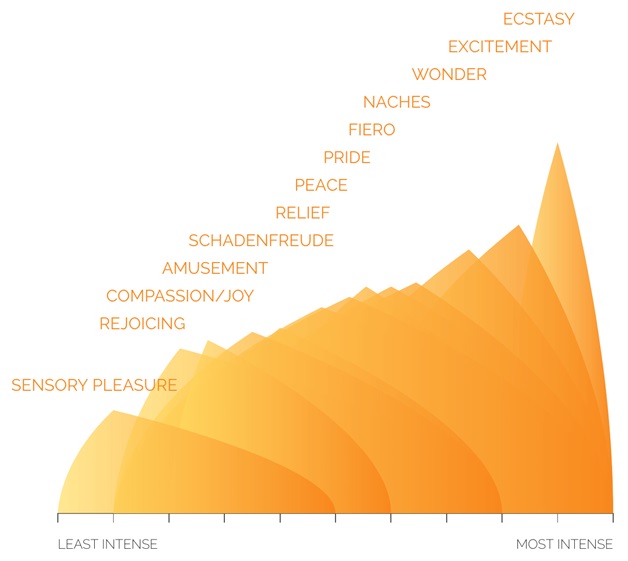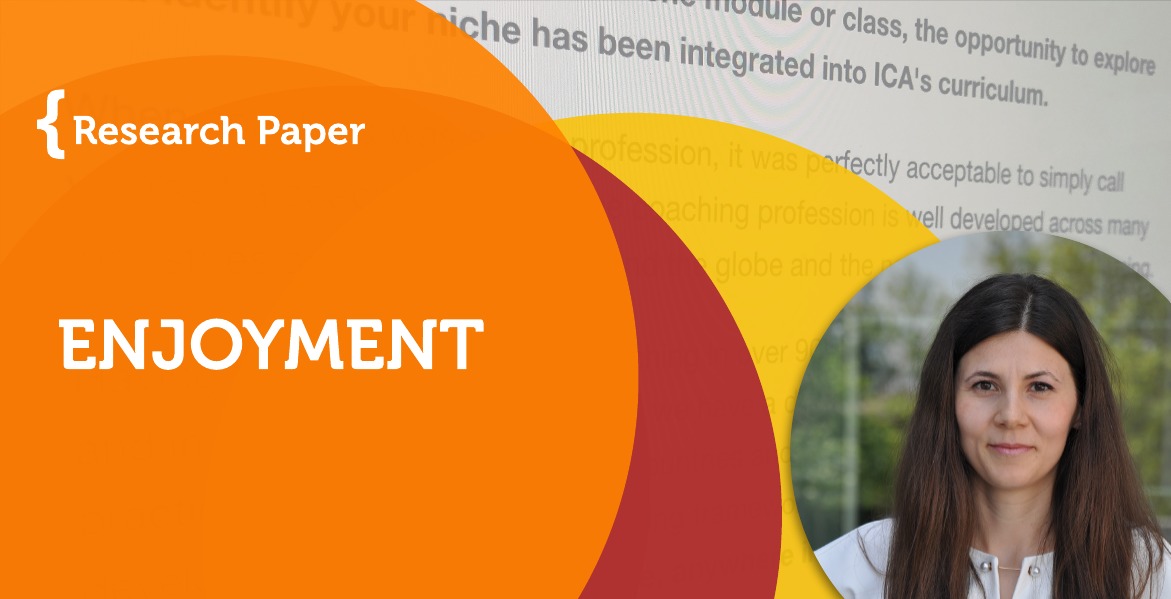Research Paper By Georgiana Puica
(Life Coach, ROMANIA)
But that’s the whole aim of civilization: to make everything a source of enjoyment. Leo Tolstoy, Anna Karenina
Introduction
Paul Ekman said that
emotions are a process, a particular kind of automatic appraisal influenced by our evolutionary and personal past, in which we sense that something important to our welfare is occurring, and a set of psychological changes and emotional behaviors begins to deal with the situation.
There are many studies of core emotions. Based on Paul Ekman’s research there are six basic emotions: anger, disgust, fear, sadness, surprise, and enjoyment. If we look at the six basic emotions, we can conclude easily that “enjoyment” must be the most desirable of all.
I started the coaching journey with this desire to discover for myself what makes me feel joy, what enjoyment is for me, to find more sense, and further using my knowledge to help other people discover what they enjoy and what is enjoyment for them.
I believe that being aware of what matters for each of us makes us MOVE (see my coaching model).
This research paper does not cover all aspects, studies, or concepts about enjoyment, but covers some parts that to me seem to be rather correlated with my work as a coach.
In the next pages, the main concepts discussed and key points touched are:
Definition
When we talk about the enjoyment we can refer to:
Enjoyment states
Based on the Paul Ekman “Atlas of Emotions”, the Enjoyment states are as presented below:
 Source: Atlas of Emotions
Source: Atlas of Emotions
What is the difference between the meanings of enjoyment:
Happiness vs Satisfaction
Daniel Kahneman considers that happiness and satisfaction are distinct:
Happiness (experience self) is a momentary experience (experiences that leave people feeling good) that arises spontaneously and is fleeting, passing. A person who had many happy moments may not feel pleased on the whole.
Happiness occurs in real-time.
We feel happy in the company of others, friends, family, children. Happiness depends also on our natural ability to be a happy and genetic disposition to optimism.
Satisfaction (remembering self) is a long-term feeling, built over time and based on achieving goals and building the kind of life you admire.
Satisfaction is retrospective.
Life satisfaction is also connected to a comparison with other people.
The reason we look for as many happy experiences (like going on vacation) is that we do things in anticipation of creating satisfying memories to reflect on later. We’re somewhat less interested in actually having a good time, but more in creating long term satisfaction.
Daniel Kahneman stated that he was “fairly happy – mainly because, for most of my life, I’ve worked with people whose company I enjoyed”.
Measuring enjoyment
“Well-being bears a complicated relationship to monetary measures. The wealth of nations does not equate to their happiness” (Veenhoven (1984). A helpful distinction can be made between ‘global evaluative judgments’ and ‘feelings of pleasure and displeasure summated over time’. Both contribute to well-being, and neither on its own constitutes happiness.
When evaluating the favorableness of their lives, people tend to use two sources of information: their feelings and thoughts. These two approaches may result in different judgments of life-as-a-whole. An individual can acknowledge that he ‘feels fine’ most of the time and he can also conclude that life does bring him ‘all he wants’.
When defining happiness, Veenhoven (1984) distinguishes between “overall happiness” and the two components of happiness:
- Feelings – the hedonic level of effect – how well a person fees most of the time. It does not require a thinking activity, but a distinction between pleasant and unpleasant activity. It is more an involuntary activity as to whether we want or not we have some feelings.
- Thoughts – contentment – “is the degree to which an individual perceives that his aspirations are being met”. Contentment requires a minimum of self-reflection and is a voluntary activity.
There are a lot of factors influencing the measurement of enjoyment (e.g. judgment, consistency over time, subjectivity, comparison, etc). One of the ways we can try to assess it is by asking people about it.
Martin Seligman, a psychologist, promoter of positive psychology, developed a PERMA model including the characteristics of a fulfilled, happy, and meaningful life. Each letter of the model stands for:
Positive Emotions – Remain optimist and see the past, present, and future from a constructive point of view, focusing on the full part of a glass. There is a distinction to be made between pleasure (satisfying basic body needs like thirst, hunger, sleep, etc) and enjoyment (from intellectual satisfaction and creativity).
Engagement –People have a high level of engagement (or are absorbed in what they do) when they are involved in activities they love and are good at, such as dancing, playing a sport, or pursuing creative activities and hobbies. The level of engagement in one activity is important for health and happiness and also increase in skills.
Relationships – Happiness and psychological health are linked with close, meaningful, and healthy relationships. Creating social relationships with colleagues, siblings, parents, extended family, and friends result in a higher level of enjoyment. According to research, one important aspect of social networks is that they can spread happiness, cheer, and laughter, while isolation is something that increases our pain.
Meaning –Having a meaning gives a feeling of satisfaction. Understanding the meaning of what you do, the impact of your activities at work, at home, increase awareness and enjoyment. Religious and spiritual people have a more meaningful life as they believe in something greater than themselves.
Achievement –Setting goals and taking steps to achieve them increase happiness. The accomplishments of the steps and at the end of goals increases self-esteem and self-believe.
Being aware of the elements of PERMA model and integrated it or small steps in your life (looking at things that you enjoy, involve in the activities you enjoy often, having and build a close relationship, look for the meaning of your life, set and achieve goals) might increase the level of happiness, satisfaction and sense of purpose.
Happiness and one’s place in society
Living conditions are different for all members of society, there are differences between individuals, between social categories, between men and women. The differences refer to economics, social power, access to knowledge, ways of interacting with others, etc. A summary of some existing studies presented in Veenhoven (1984) shows mainly the following conclusions:
Gender: all over the world women appear equally happy as men, yet the young women are happier than young men and elderly men happier than elderly women mostly due to differences in marital status.
Age: people of different ages appear equally happy on average based on “overall happiness”.
Income: rich people are generally happier than poor ones.
Education: higher educated people are happier than poorly educated people. Education contributes to happiness mostly by adding the change to gain more income.
Occupational prestige: people with prestigious occupations are happier than people in fewer contempt occupations.
Theories about happiness
Since ancient times, happiness has been thought of as having at least 2 components: pleasure (hedonia) and a sense of a life well-lived (eudaimonia).
The difference between eudaimonia happiness is that this is mostly defined in the happiness literature through authenticity, excellence, meaning, and growth, while hedonic happiness mostly defined through life satisfaction, enjoyment, and pleasure.
Below are briefly explained the two theories:
A: Hedonism (individualistic)
As included in the Wellbeing book: Foundation of hedonic psychology, by Daniel Kahneman, Edward Diener, Norbert Schwarz, “Hedonic psychology is the study of what makes experiences and life pleasant or unpleasant. It is concerned with feelings of pleasure and pain, of interest and boredom, of joy and sorrow, and satisfaction and dissatisfaction. It is also concerned with the whole range of circumstances, from the biological to the societal, that occasion suffering and enjoyment.”
On another uncle, there is the concept of “hedonic adaptation” or “hedonic treadmill” that is talking about the people tend to return to a stable level of happiness, despite the positive or negative peaks in their life, activity. Based on this concept, if you gain more money at work, your desires increase by the same level this resulting in the same level of happiness.
Utilitarianism (social hedonism)
Utilitarianism is a theory founded by Jeremy Bentham and revised by John Stuart Mill “that promotes actions that maximize happiness and well-being for the affected individuals based on which an action is right if it tends to promote happiness and wrong if it tends to produce the reverse of happiness—not just the happiness of the performer of the action but also that of everyone affected by it”.
B: Eudaimonia
The etymology of” Eudaimonia” is “EU” (good) and “daimon” (spirit).
The term was first used by Aristotle who considered that due to man’s capacity to reason (compared to animals), pleasure alone cannot determine happiness. According to Aristotle, happiness comes from” activity expressing virtue”.
Advocates of “Eudaimonism” sustain that people should live by the daemon (i.e. true self), and this will determine the greatest fulfillment.
Waterman introduced the concept of “personal expressiveness” which is linked with the feelings associated with intrinsic motivation (Deci & Ryan, 1985). It describes the state of authenticity that occurs when people’s actions reflect their values.
Positive psychology – Martin Seligman view on happiness
Positive psychologists Christopher Peterson and Martin Seligman (2004) developed a classification system of strengths named Values in Action (VIA) strengths survey (it is similar to the one developed by Clifton and colleagues at Gallup named the Clifton StrengthsFinder). It classifies the strengths in 24 categories (i.e. wisdom and knowledge, curiosity, courage, humanity, justice, temperance, transcendence) and subcategories. Identification of top strengths of people in the coaching process helps in highlighting what motivates and inspires the client, thus helping the coach to help the client in finding ways to improve performance and satisfaction in goals accomplishment.
Based on this classification system, out of the 24th strengths, the ones that are most correlated with happiness are gratitude, curiosity, vitality, hope, and the capacity to love.
The Seligman definition of happiness as described in his book “Authentic Happiness” combines historic theories as of Aristotle with modern psychological theories of motivation and arrived in three components:
- the Pleasant life – appreciate basic needs, pursues the positive emotions about the present, past, and future;
- The good life –discover our unique virtues and strengths and use them to enhance our lives.
- Meaningful life – find a deep sense of fulfillment by using our unique strengths in the service of others.
Conclusion
Some authors based on their researches sustained that external factors like success, money, etc are not the critical factors in understanding happiness and that we should focus more on internal factors. In other words, it isn’t what happens to people, it’s how they construct and interpret those events (Schwartz & Strack,1999). This leads us to the fact that coaching can influence an increase in happiness.
Part of coachwork should be focused on helping the client increase their emotional awareness which in turn will help them move towards their goals.
Creating awareness on their strengths and values, what is truly meaningful to the client is part of the journey towards an enjoyable life (happiness and life satisfaction).
The coach can help the client increase happiness through each of the three “types of life” identified by Seligman in “Authentic happiness”.
References
Daniel Kahneman Gave Up On Happiness
National Utility Measuring the Enjoyment of Activities
Veenhoven, R. (1984). Conditions of happiness. Dordrecht/The Netherlands: Reidel/Springer Press.
https://en.wikipedia.org/wiki/Daniel_Kahneman
- Ekman, Emotions revealed: recognizing faces and feelings to improve communication and emotional life, New York, Henry Holt And Company, 2003.
https://www.paulekman.com/universal-emotions/
Well-Being: Foundations of Hedonic Psychology, Daniel Kahneman, Edward Diener, Norbert Schwarz
https://positivepsychology.com/perma-model/
https://positivepsychology.com/eudaimonia/
https://positivepsychology.com/psychology-of-happiness/
https://www.pursuit-of-happiness.org/history-of-happiness/martin-seligman-psychology/
